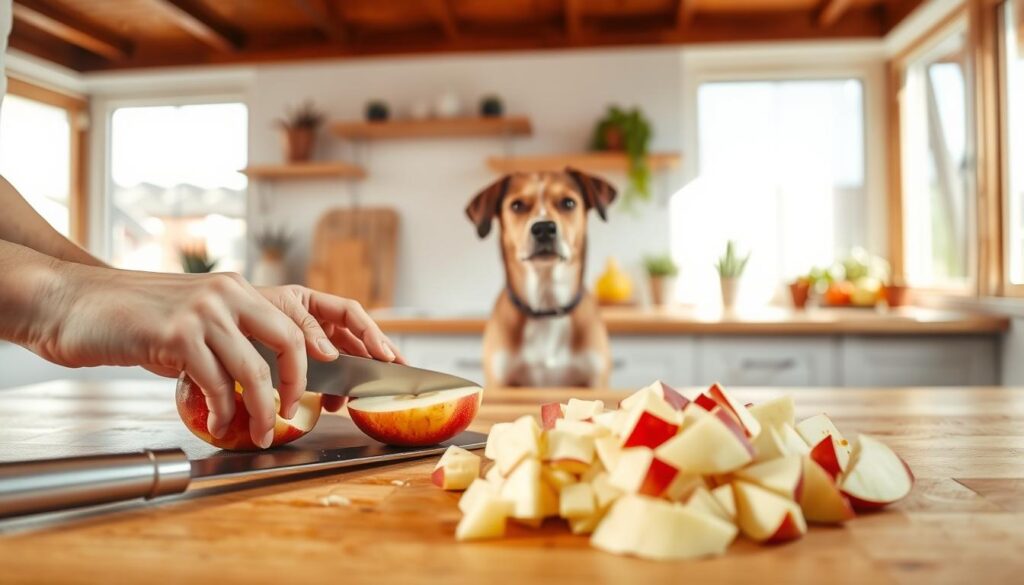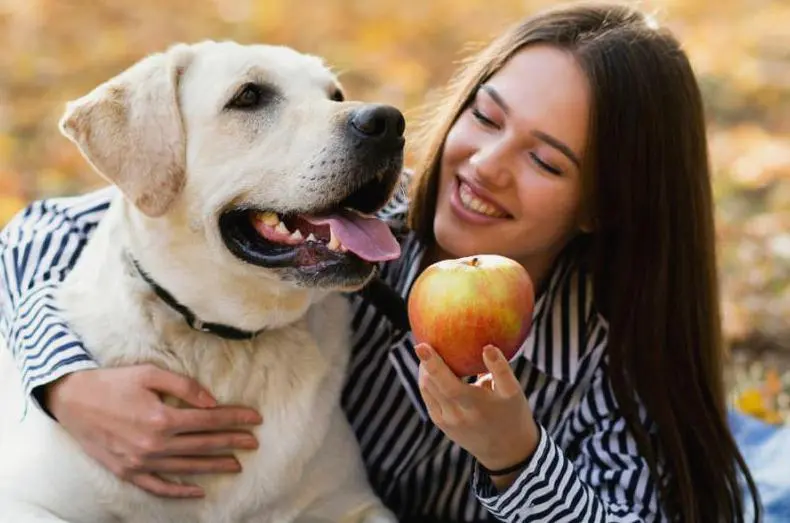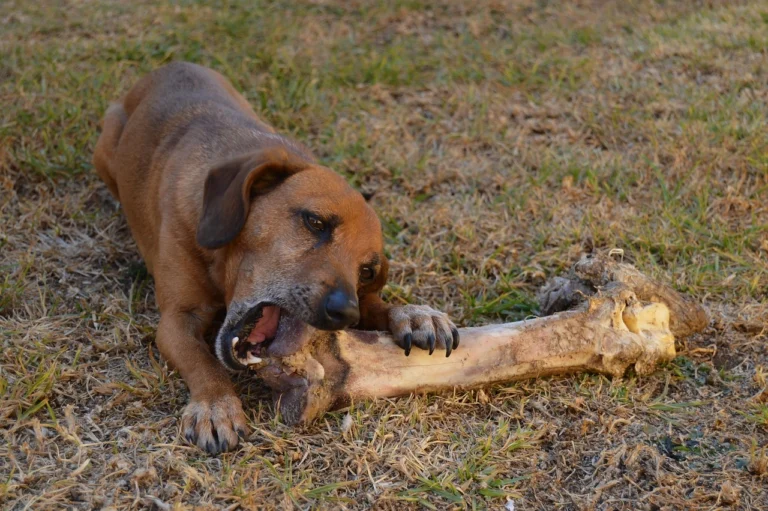Are Apples Good for Dogs? Nutrition Facts Explained 101
As a dog owner, I once wondered if it was safe to share an apple slice with my pet. Many pet parents have the same question during snack time.
Is it okay to give dogs apples? Apples can be a healthy treat for dogs if given correctly. They offer many health benefits that support your dog’s well-being.
Vets say that apples are good for dogs if prepared right. The key is to serve them in moderation. Apples are full of vitamins, minerals, and fiber that can boost your dog’s health.
Before giving apple slices to your dog, it’s important to know how to do it right. Not all parts of the apple are safe. There are guidelines to follow to keep your dog safe and happy.
In this guide, we’ll cover everything about giving apples to dogs. You’ll learn about their nutritional benefits and potential risks. We’ll show you how to make apples a safe and tasty treat for your dog.
Table of Contents
The Health Benefits of Apples for Dogs
Apples are more than just a tasty treat for your furry friend. They are packed with nutrients that can greatly improve your dog’s health. These fruits offer essential nutrients that support your dog’s well-being.
Understanding the nutritional profile of apples is key. Let’s look at how apples can benefit your dog’s health.
Vitamin and Mineral Powerhouse
Apples are full of nutrients that support your dog’s health. They contain:
- Vitamin A for eye health
- Vitamin C to boost immune function
- Potassium for muscle and nerve support
- Antioxidants that fight cellular damage
Digestive Health Support
The fiber in apples is great for your dog’s digestion. It acts as a natural prebiotic, supporting healthy gut bacteria and smooth digestion.
| Fiber Benefit | Impact on Dog’s Health |
|---|---|
| Pectin | Supports healthy gut microbiome |
| Dietary Fiber | Regulates bowel movements |
| Prebiotic Properties | Promotes digestive system balance |
Dental Health Advantages
Apples can act as a natural toothbrush for your dog. Their crunchy texture helps remove plaque and tartar, naturally freshening breath and supporting oral hygiene.
“An apple a day might just keep the doggy dentist away!” – Veterinary Nutrition Experts
Remember to remove seeds and core before giving apples to your dog. This ensures a safe and healthy treat that supports their overall well-being.
Are Apples Good for Dogs: A Complete Safety Guide
Wondering if apples are safe for dogs? It’s a big question for many pet owners. The truth is, apples can be a healthy snack for dogs if prepared right.
Before giving apples to your dog, follow these important safety tips:
- Always remove apple seeds and core completely
- Cut apples into small, bite-sized pieces
- Introduce apples gradually into your dog’s diet
- Watch for any allergic reactions or digestive issues
Whether apples are safe for dogs depends on how you prepare them. Treat them as an occasional snack, not a main food. Dogs digest food differently than humans, so what’s safe for us might not be for them.
“Moderation is the secret to safely sharing human foods with your canine companion.” – Veterinary Nutrition Experts
There are risks like choking from big pieces, upset stomach from eating too much, and allergies. Some dogs might get a little stomach upset or diarrhea when they try apples for the first time.
It’s important to watch how your dog reacts. Start with tiny pieces and see how they do. If they show signs like vomiting, too much gas, or acting differently, stop giving them apples and talk to your vet.
Pro tip: Organic apples are better to avoid pesticides that could harm your dog.
Nutritional Value of Apples for Canines
Learning about the health benefits of apples for dogs can guide you in feeding them. These fruits are full of nutrients that support your dog’s health.
Apples are more than a tasty snack for dogs. They have many nutritional benefits that can improve your dog’s diet.
Water Content and Hydration
Apples are about 86% water, making them a great way to keep dogs hydrated. This water helps keep your pet refreshed and supports their fluid needs. Feeding dogs apples can be a tasty way to add to their water intake.
Antioxidant Properties
The skin of apples is a nutritional powerhouse. It’s full of antioxidants that offer health benefits for dogs:
- Supports immune system function
- Potentially helps reduce joint disease symptoms
- May provide cancer-fighting properties
Natural Sugar Content
Apples have natural sugars, but they can be a healthy treat for dogs in small amounts. Here’s a quick look at apple nutritional content:
| Nutrient | Amount per Medium Apple |
|---|---|
| Calories | 95 |
| Fiber | 4.4 grams |
| Vitamin C | 8.4 mg |
| Potassium | 195 mg |
Remember, apples should be an occasional treat, not a main part of your dog’s diet. Always remove seeds and core before giving them to your dog to keep them safe.
Potential Risks and Dangers of Feeding Apples to Dogs
Apples can be a healthy treat for dogs, but there are risks to consider. Knowing these dangers helps keep your dog safe and healthy while they enjoy apples.
Choking is a big risk with apples. The core and seeds are the biggest dangers. Small dogs are especially at risk.
- Apple seeds have a bit of cyanide, which can be harmful in big amounts
- Hard apple cores can block the intestines or cause choking
- Unripe or dirty apples might have bad bacteria
When giving apples to dogs, it’s important to prepare them carefully. Always take out the seeds and core. Cutting apples into small pieces helps avoid choking.
Some dogs might have stomach problems after eating apples. Look out for signs like:
- Stomach upset
- Diarrhea
- Allergic reactions
It’s important to give apples in small amounts. Start with a little and watch how your dog reacts. Talking to your vet can help figure out if apples are safe for your dog.
How to Properly Prepare Apples for Your Dog
Feeding dogs apples can be a delightful and nutritious treat when done correctly. Proper preparation is key to ensuring your furry friend enjoys apple snacks safely and comfortably.

Before serving apple treats to your dog, follow these essential preparation steps:
Washing and Cleaning Techniques
- Rinse apples thoroughly under cool running water
- Gently scrub the apple surface to remove dirt and potential pesticides
- Use a clean produce brush for extra cleaning
- Pat dry with a clean kitchen towel
Safe Cutting and Serving Methods
When preparing apple snacks for dogs, cutting technique matters:
- Remove seeds and core completely
- Cut apples into small, bite-sized cubes or thin slices
- Consider peeling for easier digestion, especially for smaller dogs
- Aim for pieces no larger than 1/2 inch to prevent choking
Pro tip: Always supervise your dog when introducing new treats like apple slices to ensure safe consumption.
By following these preparation guidelines, you’ll create safe and enjoyable apple treats that your dog will love while supporting their nutritional health.
Safe Serving Sizes: How Much Apple Can Dogs Eat
Feeding dogs apples needs careful thought about the right amount. Apples should be a special treat, not a full meal. Vets say treats like apples should make up no more than 10% of a dog’s daily calories.
The amount of apples a dog can have depends on their size and weight. Here’s a guide to help you figure out how much:
- Extra-small dogs (2-20 lbs): 1-2 small apple pieces
- Small dogs (20-30 lbs): 2-3 apple slices
- Medium dogs (30-50 lbs): 4-6 apple pieces
- Large dogs (50-90 lbs): 8-12 apple slices
- Extra-large dogs (90+ lbs): Up to 18 apple pieces
Begin with small amounts when adding apples to your dog’s diet. Look out for any signs of upset stomach or allergies. Always take out the seeds and core, as they can be dangerous. Cut apples into small pieces to avoid choking and make them easier to digest.
Pro tip: Moderation is key when feeding dogs apples. Introduce new foods slowly and observe your pet’s response.
Every dog is different. Some might handle apples better than others. Talk to your vet to find the best serving size for your dog’s needs.
Apple Parts to Avoid: Seeds, Cores, and Stems
When thinking about are apples safe for dogs, it’s key to know which parts are risky. Apples can be good for dogs, but some parts can harm them.
Dogs enjoy crunchy snacks, but not all apple parts are safe. When you ask “can dogs eat apples,” you get important safety tips about certain parts.
Cyanide Risk in Apple Seeds
Apple seeds have amygdalin, a compound that turns into cyanide when digested. While a few seeds might not hurt, eating them often can be risky for dogs.
- Remove all seeds before serving apples
- Never allow dogs to eat apple cores
- Cut apples into small, seedless pieces
Choking and Blockage Hazards
Apple cores and stems are choking hazards for dogs. Their tough texture can get stuck in your dog’s throat or block their intestines.
- Always supervise your dog when eating apple slices
- Cut apples into small, manageable chunks
- Discard stems and hard core sections
Pro tip: When preparing apples for your dog, think safety first. Slice carefully, remove all seeds, and watch your pet enjoy this healthy snack.
Creative Ways to Serve Apples to Your Dog
Turning apple snacks into fun treats can make mealtime exciting for your dog. They’ll enjoy these tasty and healthy apple options that are more than just slices.

Here are some yummy apple treats for dogs that will make them happy and healthy:
- Frozen Apple Chunks: Dice apples into small cubes and freeze for a refreshing summer treat
- Apple Training Rewards: Cut tiny apple pieces as low-calorie training incentives
- Apple-Yogurt Popsicles: Blend apples with plain yogurt and freeze in small molds
- Dehydrated Apple Chips: Thinly slice and bake at low temperature for crunchy snacks
When making apple snacks for dogs, always take out the seeds and cores. These can be dangerous and might cause choking.
| Treat Type | Preparation Time | Dog-Friendly Rating |
|---|---|---|
| Frozen Apple Chunks | 5 minutes | ★★★★☆ |
| Apple-Yogurt Popsicles | 15 minutes | ★★★★★ |
| Dehydrated Apple Chips | 2-3 hours | ★★★☆☆ |
Pro tip: Introduce new apple treats gradually and watch for any allergic reactions or digestive issues.
Signs of Apple Allergies and Intolerance in Dogs
When you add apples to your dog’s diet, it’s key to watch for allergic reactions and intolerances. Are apples safe for dogs? Most dogs love this treat, but some might have bad reactions that need watching.
Dogs and apples can be tricky. Allergic reactions show up in several ways:
- Skin irritations and unexplained itching
- Sudden swelling around the face or mouth
- Persistent sneezing or coughing
- Respiratory difficulties
- Hives or visible skin bumps
Digestive issues show up differently. Look out for:
- Vomiting after eating apples
- Diarrhea or loose stools
- Stomach discomfort or too much gas
- Reduced appetite
“Always introduce new foods gradually and observe your dog’s reaction carefully.” – Veterinary Nutrition Experts
If your dog has severe symptoms like trouble breathing or big swelling, call your vet right away. These could mean a serious allergy that needs a vet’s help.
Every dog is different. What’s good for one might not be for another. Start with small apple bits and watch your dog closely to see if apples are safe for them.
Alternative Apple Products: Applesauce and Treats
Exploring creative apple snacks for dogs can be a delightful way to introduce variety into your pet’s diet. There are many options for apple treats for dogs that are both nutritious and fun.
Pet owners have exciting choices for apple products that make treat time healthy and tasty.
Homemade Apple Treats
Making apple treats for dogs at home is simple and rewarding. Here are some easy recipes:
- Baked Apple Chips: Thinly slice apples and bake at low temperature until crisp
- Frozen Apple Cubes: Blend unsweetened applesauce and freeze in small portions
- Apple Peanut Butter Balls: Mix mashed apple with natural peanut butter
Store-Bought Apple Snacks for Dogs
When choosing commercial apple dog treats, check the ingredient list carefully. This ensures quality and safety.
| Product Type | Key Considerations | Recommended Brands |
|---|---|---|
| Applesauce Treats | Unsweetened, no artificial additives | Buddy Fruits, Natural Balance |
| Dried Apple Treats | No added sugars, minimal processing | Wellness, Zuke’s |
| Apple-Flavored Biscuits | Natural ingredients, whole food sources | Blue Buffalo, Happy Howie’s |
“Moderation is key when introducing any new treat to your dog’s diet.” – Veterinary Nutrition Experts
Always introduce apple treats slowly and watch for any bad reactions. Portion control is key to keep your dog healthy and avoid digestive problems.
Conclusion
Exploring if apples are good for dogs can be reassuring. This fruit brings many nutritional benefits when given right. Dogs and apples can have a healthy snacking relationship if you follow key safety tips and keep it in moderation.
It’s important to know how to prepare apples for dogs. Always take out seeds, stems, and cores to avoid health risks. Small, bite-sized apple pieces can be a nutritious treat that boosts your dog’s health. Remember, every dog is different, so start with small amounts to see how they react.
Before making big changes to your dog’s diet, talk to your vet. They can give advice that fits your dog’s health needs. This way, adding apples to their diet can be safe and fun for them.
In the end, whether apples are good for dogs depends on careful preparation and knowing your pet’s diet needs. With the right care, apples can be a tasty, healthy part of your dog’s diet, helping their health and giving them a yummy treat.







